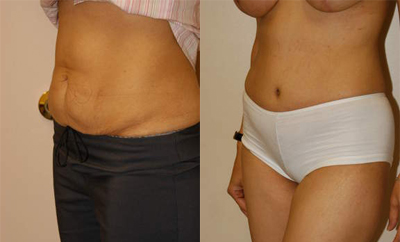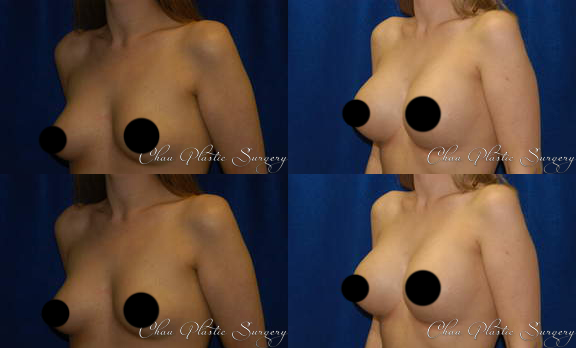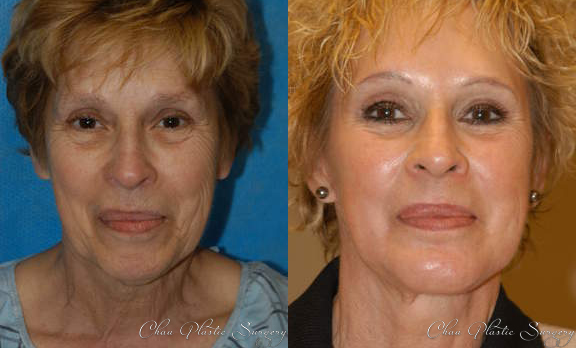
Birmingham Facelift
Serving Birmingham, Metro Detroit & Michigan For Over 30 Years
At Chau Plastic Surgery. we strive to provide you with the best results. We will take the time to discuss all the options available to you so you can make an informed decision that best fits with your goals.
About Our Practice
Facelift Specialists Serving Birmingham, Michigan
The facelift (aka rhytidectomy) is one of the most popular facial rejuvenation procedures that the specialists at Chau Plastic Surgery perform for men and women in the Metro Detroit Area. With a rhytidectomy, an experienced surgeon can turn back the hands of time. Since there are a couple of rhytidectomy options, during a patient’s initial consultation, our surgeon determines which procedure can provide optimal results.
Why Would Someone From Birmingham, Michigan, Have a Facelift?
People choose to have a rhytidectomy to appear more youthful. A more youthful appearance can increase an individual’s self-confidence level. In addition, appearing more youthful helps some people remain competitive in the workplace.
A Traditional Facelift vs. a Mini Lift
The goal of a rhytidectomy is to restore any shapeliness and volume the face has lost. So, the patient appears refreshed and more youthful.
A traditional facelift addresses the signs of aging by lifting and tightening the skin on the face and neck. This lifting and tightening will smooth the skin to provide the patient with a more youthful appearance.
A mini facelift (aka mini lift) is a modified version of the traditional rhytidectomy. The mini-lift targets the lower section of the face (around the chin and jawline).
A Neck Lift
Many times, patients have a neck lift at the same time as their rhytidectomy. If the patient is also having a neck lift, the surgeon removes excess fat and loose skin on the neck.
Which Signs of Aging Does a Traditional Rhytidectomy and Neck Lift Address?
A traditional rhytidectomy with a neck lift near Birmingham, Michigan, can improve many signs of aging on the face and neck.
These signs include:
- The relaxed skin and facial tissues that cause sagging in the face.
- The deep folds that develop between the corners of the mouth and the base of the nose (i.e., nasolabial folds).
- The sagging skin in the cheeks and jaw (i.e., jowls).
- Hollow-looking areas of the face resulting from fallen or diminished facial fat.
A neck lift addresses the loose tissues and skin in the neck. Excess tissue and skin in this area can result in the development of a double chin or a turkey neck.
At Chau Plastic Surgery, our surgeons use their surgical skill, artistic vision and experience to create each of their patients a personalized procedure plan.
What Causes the Signs of Aging?
As we age, the layers of the face and neck begin to loosen, causing the signs of aging to develop.
Factors that can cause the signs of aging:
- Gravity.
- Smoking.
- Stress.
- Thinning of the skin.
- Genetics.
- Loss of facial fat.
- Sun damage.
Do People Still Look Like Themselves After a Facelift?
A rhytidectomy is a rejuvenation procedure, which means, that as long as an experienced plastic surgery specialist performs this procedure, it doesn’t change an individual’s fundamental appearance.
Since the specialists at Chau Plastic Surgery are board-certified and highly experienced when they perform facial plastic surgery procedures for rejuvenation purposes, our patients look like themselves; they just appear more youthful.
At What Age Should Someone Consider Having a Facelift?
There isn’t any specific age when someone should consider having a rhytidectomy. An individual typically considers having a facial rejuvenation procedure when they notice the signs of aging. Generally, people start seeing wrinkles in their 40s or 50s. It is at this point that the majority of people decide to have a facial rejuvenation procedure. However, in recent years there has been an increase in the number of people requesting a facelift consultation in their 30s.
A Facelift Consultation Near Birmingham, Michigan
During a consultation for a rhytidectomy, patients need to inform their surgeon about the medications, herbal supplements and vitamins they take regularly. In addition, they must provide their surgeon with information about allergies, previous surgeries, treatments and conditions (e.g., diabetes). The surgeon also wants to know if the patient drinks alcohol, smokes or uses recreational drugs.
To provide optimal results, the patient must be able to explain what they would like to accomplish with a facelift. The surgeons at Chau Plastic Surgery also encourage patients to ask questions during this consultation.
The surgeon:
- Evaluates the patient’s general health status.
- Reviews any pre-existing conditions and considers risk factors.
- Examines and takes measurements of the patient’s face.
- Recommends the facelift procedure that can provide the results the patient desires.
- Discusses the likely outcome of a rhytidectomy as well as the risks and potential complications.
- Informs the patient about their anesthesia options.
- Discusses what they can expect as they recover.
If the patient decides to move forward with treatment, the surgeon:
- Takes photos of their face and neck.
- Creates a personalized surgical treatment plan.
Preparing for a Facelift Near Birmingham, Michigan
For the 10 days leading up to surgery, patients need to discontinue using certain medications or adjust their current dosage. These medications include aspirin, non-steroidal anti-inflammatory drugs (NSAIDs) and blood thinners (e.g., Pradaxa). Additionally, patients must discontinue using herbal supplements (e.g., Gingko Biloba) and taking certain vitamins (e.g., Vitamin E) during this timeframe. These products can increase bleeding and bruising.
Patients using tobacco must discontinue using these products for at least three weeks before and after their facelift near Birmingham, Michigan. Following this recommendation is essential because the nicotine in tobacco negatively affects the healing process.
A Birmingham, Michigan, patient may need to undergo a medical examination and have lab tests before their rhytidectomy. Patients must complete this examination and lab tests a week before their procedure. This gives their surgeon enough time to review the results.
Schedule time off work. Patients having a traditional facelift need to take about two weeks off, and those having a mini lift need to take about a week off work for recovery.
Since patients receive anesthesia during their surgery, on the day of their rhytidectomy, they need a driver. Patients must also have someone remain with them for at least 24 hours.
For-Hire Transportation After Surgery
To ensure our patients aren’t taken advantage of by people with nefarious intent, we don’t permit the use of for-hire transportation following surgical procedures. Therefore, if a Birmingham, Michigan, patient arrives at the hospital without a driver, they must reschedule their procedure.
A Rhytidectomy Near Birmingham, Michigan
It takes from two to five hours to perform this facial rejuvenation procedure. The length of a patient’s surgery depends on the type of rhytidectomy they are having.
The Traditional Facelift, a Mini Lift and a Neck Lift: Procedure Steps
Step 1: Anesthesia
To ensure patients remain comfortable, they receive general anesthesia or intravenous sedation. These medications cause them to stay asleep during their surgery.
Step 2: Making the Incisions: Incision Location Depends on the Procedure
The type of surgery a Birmingham, Michigan, patient has determines where their surgeon creates their incisions. Nonetheless, all incision lines are well hidden, following the contours of the patient’s ear and face.
-
The Traditional Rhytidectomy
The traditional rhytidectomy incision typically begins in the patient’s hairline at the temples, continues around the ear, and ends in the lower scalp.
With this incision, the surgeon may redistribute or sculpt the fat in the face.
The specialist repositions the patient’s underlying tissues. The muscles and deeper layers of the face may also be lifted.
The surgeon redrapes the skin and trims away any excess.
Some Birmingham, Michigan, patients receive a second incision beneath the chin. The specialist uses this incision to rejuvenate the neck.
-
The Mini Facelift
The incision for a mini lift is shorter. It begins at the temples and continues around the ear.
The surgeon lifts and gently pulls the skin.
Next, the specialist removes any excess skin and tissue.
After a mini lift, the patient’s jawline will be tighter and smoother.
-
The Neck Lift
This type of lift addresses loose neck skin, a sagging jawline and fat accumulation beneath the chin.
The surgeon creates this incision in front of the earlobe. It wraps around to the back of the ear, ending in the hairline behind the ear.
Step 3: Incision Closure
The surgeon uses skin adhesives or very fine sutures to close the incisions.
The sutures may be dissolvable, or their surgeon may need to remove them. This removal occurs in our Berkley, Michigan, office between the weeks of one and three of recovery.
Step 4: Results
Once the inflammation and bruising subside, Birmingham, Michigan, patients see the visible improvements the surgeon was able to achieve during their facelift. Patients will notice that they appear well-rested and more youthful.
Step 5: Bandaging the Patient’s Face
Directly after surgery, patients may receive a bandage that wraps completely around their face. This bandage helps reduce inflammation and bruising.
Step 6: Drainage Tubes
Some patients receive drainage tubes. These tubes provide a place for excess blood and fluid to exit the body. Reducing inflammation decreases the amount of discomfort a patient experiences.
Are There Any Other Procedures That Patients Can Have With a Facelift?
Yes, many of our patients from Birmingham, Michigan, choose to have eyelid surgery (i.e., a blepharoplasty) and a brow lift to rejuvenate their eyes. The brow lift can address the horizontal lines that develop across the forehead and the 11s (aka frown lines) between the eyes. The surgeon can also perform laser surgery during a rhytidectomy.
A Birmingham, Michigan, patient with hollow-looking areas (e.g., beneath the eyes and in the cheeks) may benefit from dermal filler injections or an autologous fat transfer.
The Recovery Area
Before they head home, patients receive instructions on how they can care for their drains and surgical sites, as well as whether they need to apply or take medications. In addition, they receive information about which symptoms require them to seek medical attention (e.g., an infection). They may also schedule their follow-up appointment before they leave.
A General Recovery Timeline
Recovering from a Birmingham, Michigan, facelift takes a few weeks. The first couple of days are the most difficult.
It takes about 14 days for the inflammation and bruising following a rhytidectomy to dissipate, and from two to three months for the face to feel as if it is back to normal in terms of texture and tightness. However, patients having more extensive procedures should expect their post-surgical symptoms to last longer.
The First Week of Recovery
Upon heading home, most patients still feel sleepy and are somewhat unsteady. For this reason, someone must remain with them overnight. Our surgeons recommend that their Birmingham, Michigan, patients rest when they arrive home. However, to keep inflammation down, patients should avoid lying down, and instead prop their heads up with several pillows or sleep in a recliner.
On the first day of recovery, patients need to take their pain medication as prescribed. This ensures they remain as comfortable as possible during their initial healing phase.
Once the patient awakens, and with assistance from their caregiver, patients should walk around for a few minutes. Following this recommendation is vital because patients who receive general anesthesia are at a higher risk of developing a blood clot. However, they can help prevent blood clot formation by walking around several times a day.
Since patients from Birmingham, Michigan, receive anesthesia during their facelift, they are unable to drive for 24 hours after their surgery. In addition, for safety’s sake, a patient taking prescription pain medication must not drive until they no longer need it. Therefore, someone has to drive the patient to their follow-up appointment.
-
The Follow-up Appointment
Patients usually return to Chau Plastic Surgery the day after their surgery. During this appointment, their surgeon removes the dressings to evaluate the incisions. Following this evaluation, the specialist reapplies the surgical dressings and reviews postoperative care with the patient.
Inflammation and bruising are most prevalent on days three and four. Nonetheless, once they reach the third day, patients typically begin feeling much better.
By days four to six, the majority of patients no longer need to take prescription pain medication. If patients feel well enough, they can usually start performing some light housework.
The Second Week of Recovery
Inflammation and bruising can cause tingling, numbness and a feeling of tightness. These symptoms are common following a facelift. They typically diminish within two weeks of surgery.
As patients move into week three of recovery, they can usually return to work.
The Third and Fourth Weeks of Recovery
The surgeon removes the patient’s sutures at some point between weeks one and three. This time frame is based on the particular procedure a patient has and their body’s healing process.
Residual swelling and tightness may still be present, but patients typically begin seeing the results of their facelift.
The incision sites are well hidden. At this stage of the healing process, they’ll have a pinkish hue. As long as the incision sites aren’t exposed to UV light while they’re still pink, they’ll fade.
What To Expect After the Fourth Week of Recovery
Patients should be able to return to their normal activities. However, some minor swelling, tightness and numbness may still be present. These side effects usually diminish within a year of surgery.
How Long Do Facelift Results Last?
Although nothing lasts forever, the results of this facial rejuvenation procedure can last up to 10 years. One of the best ways to prolong the results of a rhytidectomy is to wear sunscreen with an SPF of at least 30 daily. In addition, the results tend to last longer if an individual has a facelift when their skin still has some elasticity. A surgeon determines elasticity by carefully stretching the skin and seeing how long it takes the skin to snap back to its original position.
Can a Person Have More Than One Facelift?
Yes. Many patients return to have a second rhytidectomy about 10 years after their first.
Potential Complications of a Face and Neck Lift
Before having surgery, patients need to consider the risks and potential complications of a facelift and a neck lift.
Risks and potential complications:
- Excessive bleeding.
- A negative reaction to anesthesia.
- Fluid accumulation.
- Nerve injury with weakness.
- Pulmonary and cardiac complications.
- Blood clots.
- Infection.
- Chronic pain.
- Changes in skin sensations (e.g., numbness).
- Prolonged inflammation.
- Skin loss due to poor wound healing.
- Skin irregularities.
- Hair loss at the incision sites (temporary or permanent).
- Unsatisfactory results requiring additional surgery.
- Skin discoloration.
- Unfavorable scarring.
Although these complications are rare, the best way to reduce the likelihood of experiencing them is to choose an experienced, board-certified plastic surgery specialist to perform the facelift procedure.
Why People Choose Chau Plastic Surgery
The surgical expertise, custom treatment and surgical plans, and high-quality care place our plastic surgery specialists amongst the top facial rejuvenation surgeons in the Metro Detroit Area.
How Much Does a Facelift Cost?
The cost of a rhytidectomy near Birmingham, Michigan, depends on what the patient wants to accomplish. Therefore, the only way to determine how much a facelift costs is with an initial consultation.
Will Insurance Cover a Rhytidectomy and Neck Lift?
Since a rhytidectomy and neck lift are cosmetic surgery procedures, health insurance won’t cover them.
During your initial consultation, our board-certified plastic surgery specialists answer your questions, learn about your aesthetic goals, and assess your needs. Then, they’ll create a custom-designed surgical plan to help you attain the facial rejuvenation results you desire.
To learn more about the facelift procedures we offer or to schedule your initial consultation, please call (248) 799-2880. Chau Plastic Surgery is located in Berkley, Michigan. Our address is 27901 Woodward Avenue, Suite 100.




